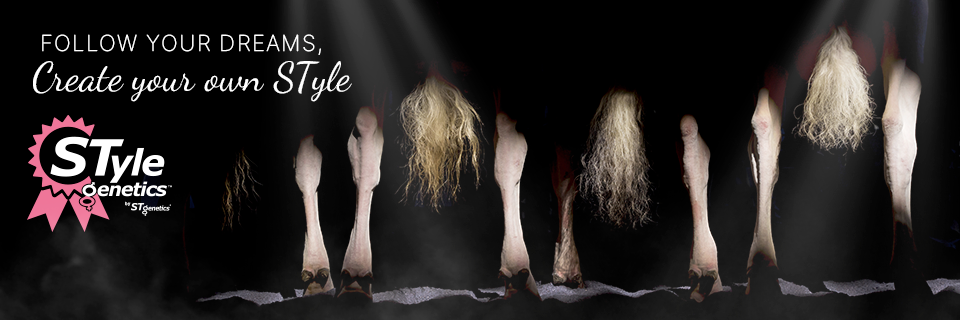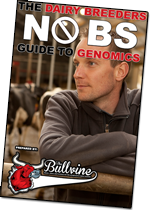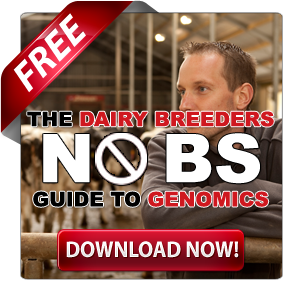There are many ways to get from Point A to Point B whether you’re on the asphalt highway or the genetic highway. A genetic plan for your herd is like a GPS – it can help you reach your genetic destination faster, with fewer detours and more profit in your pocket. It really depends on picking the coordinates that mean the most to you.
Your Future Starts Now!
The time to put in place a genetic plan is now. The bulls used will be 90% of that plan in all but the very elite genetic herds. In those herds the emphasis will be 60% bulls and 40% females. Remember that with a four year average generation interval in a herd, it means that the bulls selected this month will form the base of the herd you are milking in four to five years time.
The Clock is Ticking!
Next week will be bull selection time again for dairy cattle breeders. It’s time to decide whether to stick with the same or similar bulls or is it time to chart a new course? Over the past few month The Bullvine has covered various breeding approaches covering the spectrum from a main focus on show winning animals such as Riverside Jerseys (Read more: Riverside Jerseys: Travelling Hearts – A Girl, A Guy and Their Jersey Love Story) to a very definite focus on functional profitable cows as selected at North Florida Holsteins (Read more: NORTH FLORIDA HOLSTEINS. Aggressive, Progressive and Profitable!!). Both these breeders have a dynamic plan and they follow it successfully. Both have secured a profitable pinnacle but there are many who struggle in various low points in between. We feel their struggle relates directly to herd genetics decision planning that is unfocused or not undertaken at all.
Where Has the Money Gone?
The premium for selling good quality purebreds no longer exists. The animals that formerly sold for $4,000 to $10,000 now bring just slight over the cost of raising them. The market for replacement cows is a fraction of what it once was. With the use of technology such as sexed semen and better herd management practices, herds that formerly bought replacements have enough of their own. The few they do have to sell contributes to lowering the market price for replacements.
On the bull side, indexes for young sires are now almost twice as accurate thanks to genomics. Fewer are being sampled and incentives for young sire use or price discounting of their semen have disappeared.
Show Money is a “No Show”
There once was a market for animals that could win the county show. Today, with 4H calves being one exception, the average milk producer have discontinued exhibiting cattle. At a practical level, the large tall show type animals aren’t the best fit for modern housing facilities. The trend is that show type farms will be a much smaller portion of national herds. Where once perhaps up to 20% of farms selected bulls based mainly on their PTAT or CONF proofs, that is likely to be one in a thousand farms within five years time. Selecting bulls only on their type indexes will not position breeders to generate a profit from cattle sales or to have efficient milk production.
Where is the Money Now?
Cattle sales once made up 10 to 30% of revenue for purebred breeders. Today the milk check is the key revenue source. The embryo market does not match former cattle sale levels. The most valuable animal on the farm is no longer the 4-5 year old brood cow but the high genomic indexing 6-8 month old heifer from a proven cow family. Buyers want first lactation females only. Second and later lactation females are suspected as being sold for a problem (i.e. high SCS). Commercial breeders are speaking out for efficient more agile cows with high yields. We can expect to see the trend for high prices for the genetically elite but after that there will be little or no premium pricing.
Put Your Money Where the Bull Is
If your farm’s primary focus is profit from efficient fat and protein production, then consider using NM$ as your primary selection index. Once you have a list of bulls over NM$ of 600 you can eliminate bulls from that list based on their inferiority for traits that you feel are important.
Using second tier bulls (gTPI below 2100, gLPI below 2500 or NM$ below 600), daughter proven or genomically tested, will not give you animals or a herd that are in demand by other breeders. Red adds little to a breeding program unless you can generate significant income from cattle sales. It would be a wise move to start using polled bulls on a portion of your herd. (Read more: Is Polled the NEW Red?) It is false economy to use anything but the top bulls. Don’t skimp when it comes to buying the semen from the top bulls for genetically advancing your herd. Do not be swayed by a salesperson. They are looking out primarily for their own bottom line. It only works if it’s right for your plan. Using the right bulls will drive up your revenue and keep costs due to genetic issues under control.
Healthy is Wealthy
Using bulls with breeding values in the bottom 60% of the population for Daughter Pregnancy Rate, Daughter Fertility, SCS, Productive Life and Herd Live (below 1.0 on USA indexes of below 105 on Canadian indexes) will mean that you are not advancing the genetic merit of your herd for these increasingly important traits as fast as your fellow breeders are. Today more accurate predictions are available on bulls for their daughters’ longevity, SCS and fertility, using genomic indexes. With the increasing number of animals per worker, there is less time for individual care. Genetic selection for better health and reproduction is high on the priority list. Feet and hoof care are receiving more management attention but on the genetic side this area needs more focus. Technology, equipment and management of herds are advancing all the time and health and reproduction needs to keep up. Never forget that animal treatment and welfare are also receiving more focus. Polled is going mainline and herds with lame animals will be centered out for negative attention. (Read more: From the Sidelines to the Headlines, Polled is Going Mainline!)
The Bullvine Bottom Line
Without clear thinking, five years from now you may find you haven’t made any forward genetic progress. Analyze your genetic program. If certain decisions you made in the past are no longer producing profitable results, then be ruthless, and move on to something better. Times have changed. Have you?
Not sure what all this hype about genomics is all about?
Want to learn what it is and what it means to your breeding program?










